Demand and Supply Dynamics of Olive Oil in the Australian Market
VerifiedAdded on 2020/03/02
|6
|1440
|63
Report
AI Summary
This report examines the demand and supply dynamics of olive oil in the Australian market, drawing from the article by Erickson (2017). It explores how global supply shortages, stemming from erratic weather in major olive-producing countries like Spain, Italy, and Greece, coupled with increasing demand, especially from China, have led to significant price increases. The analysis highlights the impact on Australian consumers, who are the second-largest per capita consumers of olive oil, and discusses the implications of rising import prices. The report utilizes a supply and demand diagram to illustrate the shifts in supply and demand curves and their effect on equilibrium price and quantity. It concludes by emphasizing the need for government intervention, such as subsidies to olive oil farmers, to mitigate the impact of rising global prices and ensure a stable supply of olive oil in the Australian market. The report references several sources to support its analysis.
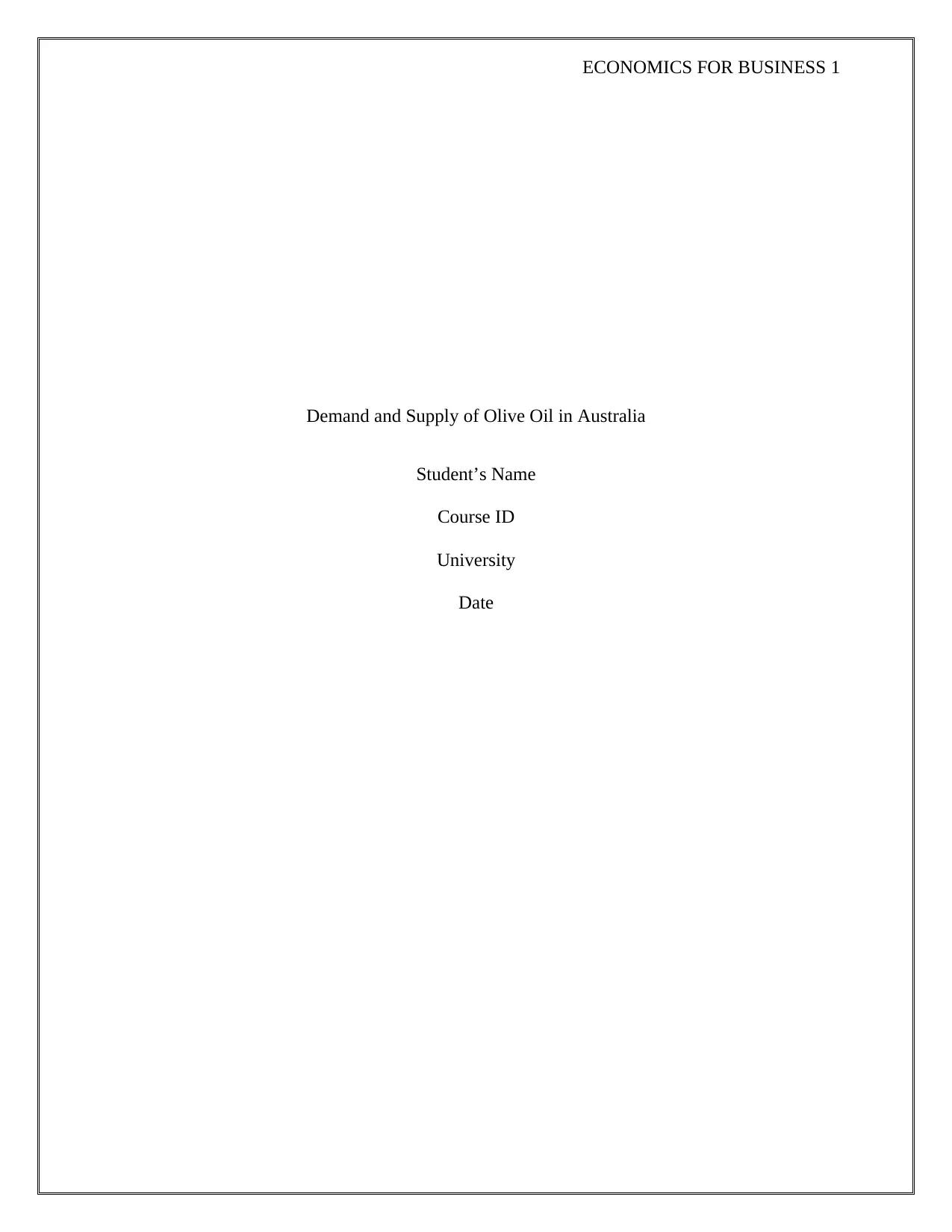
ECONOMICS FOR BUSINESS 1
Demand and Supply of Olive Oil in Australia
Student’s Name
Course ID
University
Date
Demand and Supply of Olive Oil in Australia
Student’s Name
Course ID
University
Date
Paraphrase This Document
Need a fresh take? Get an instant paraphrase of this document with our AI Paraphraser
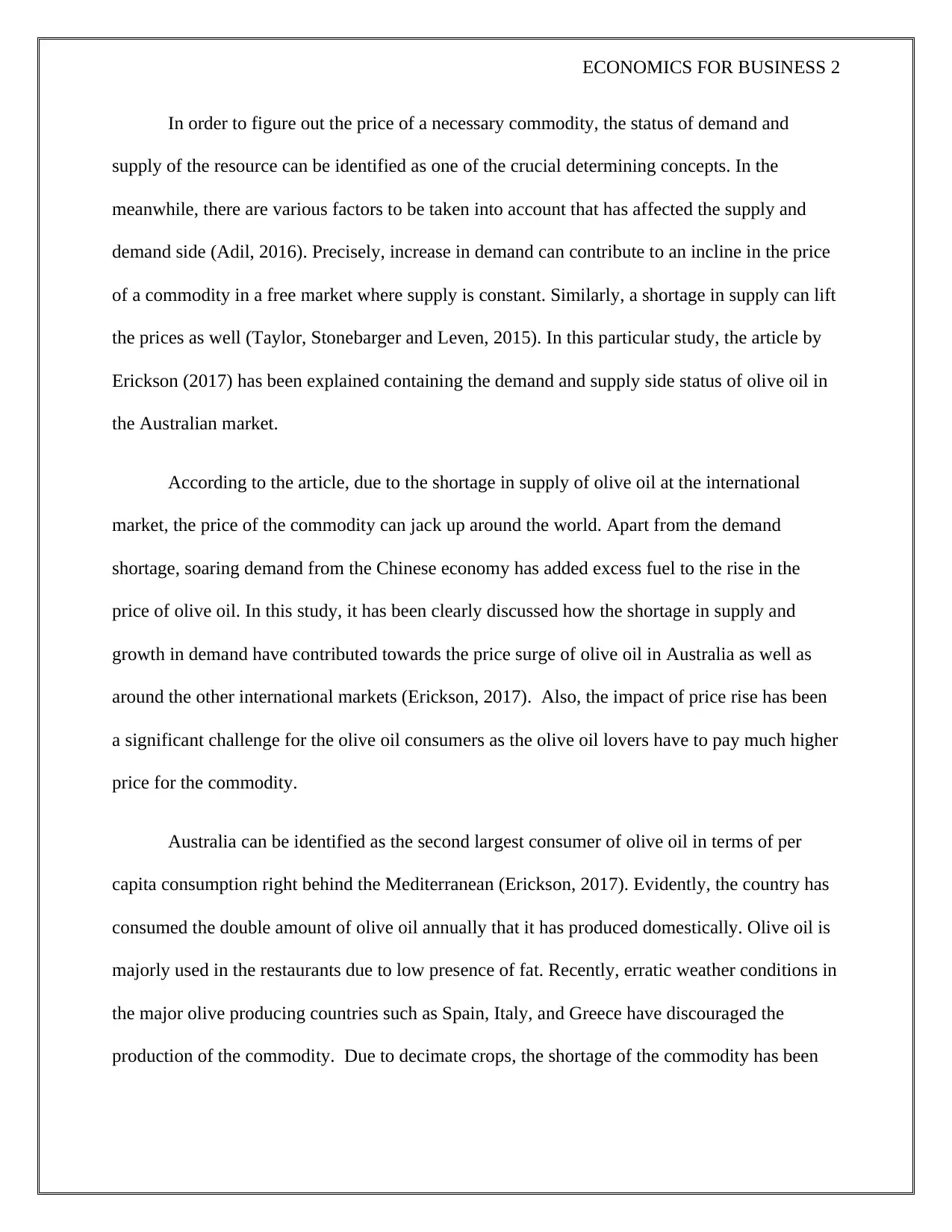
ECONOMICS FOR BUSINESS 2
In order to figure out the price of a necessary commodity, the status of demand and
supply of the resource can be identified as one of the crucial determining concepts. In the
meanwhile, there are various factors to be taken into account that has affected the supply and
demand side (Adil, 2016). Precisely, increase in demand can contribute to an incline in the price
of a commodity in a free market where supply is constant. Similarly, a shortage in supply can lift
the prices as well (Taylor, Stonebarger and Leven, 2015). In this particular study, the article by
Erickson (2017) has been explained containing the demand and supply side status of olive oil in
the Australian market.
According to the article, due to the shortage in supply of olive oil at the international
market, the price of the commodity can jack up around the world. Apart from the demand
shortage, soaring demand from the Chinese economy has added excess fuel to the rise in the
price of olive oil. In this study, it has been clearly discussed how the shortage in supply and
growth in demand have contributed towards the price surge of olive oil in Australia as well as
around the other international markets (Erickson, 2017). Also, the impact of price rise has been
a significant challenge for the olive oil consumers as the olive oil lovers have to pay much higher
price for the commodity.
Australia can be identified as the second largest consumer of olive oil in terms of per
capita consumption right behind the Mediterranean (Erickson, 2017). Evidently, the country has
consumed the double amount of olive oil annually that it has produced domestically. Olive oil is
majorly used in the restaurants due to low presence of fat. Recently, erratic weather conditions in
the major olive producing countries such as Spain, Italy, and Greece have discouraged the
production of the commodity. Due to decimate crops, the shortage of the commodity has been
In order to figure out the price of a necessary commodity, the status of demand and
supply of the resource can be identified as one of the crucial determining concepts. In the
meanwhile, there are various factors to be taken into account that has affected the supply and
demand side (Adil, 2016). Precisely, increase in demand can contribute to an incline in the price
of a commodity in a free market where supply is constant. Similarly, a shortage in supply can lift
the prices as well (Taylor, Stonebarger and Leven, 2015). In this particular study, the article by
Erickson (2017) has been explained containing the demand and supply side status of olive oil in
the Australian market.
According to the article, due to the shortage in supply of olive oil at the international
market, the price of the commodity can jack up around the world. Apart from the demand
shortage, soaring demand from the Chinese economy has added excess fuel to the rise in the
price of olive oil. In this study, it has been clearly discussed how the shortage in supply and
growth in demand have contributed towards the price surge of olive oil in Australia as well as
around the other international markets (Erickson, 2017). Also, the impact of price rise has been
a significant challenge for the olive oil consumers as the olive oil lovers have to pay much higher
price for the commodity.
Australia can be identified as the second largest consumer of olive oil in terms of per
capita consumption right behind the Mediterranean (Erickson, 2017). Evidently, the country has
consumed the double amount of olive oil annually that it has produced domestically. Olive oil is
majorly used in the restaurants due to low presence of fat. Recently, erratic weather conditions in
the major olive producing countries such as Spain, Italy, and Greece have discouraged the
production of the commodity. Due to decimate crops, the shortage of the commodity has been
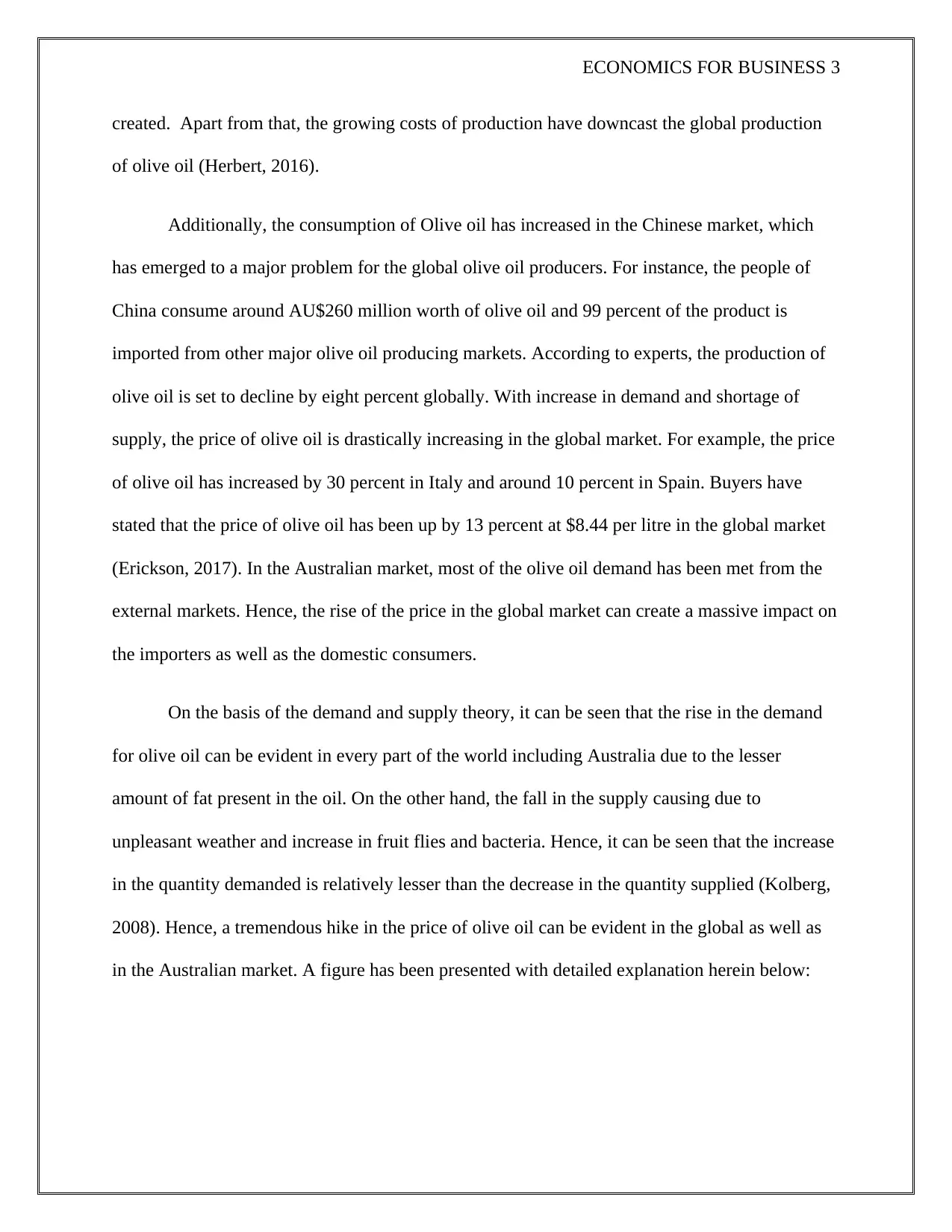
ECONOMICS FOR BUSINESS 3
created. Apart from that, the growing costs of production have downcast the global production
of olive oil (Herbert, 2016).
Additionally, the consumption of Olive oil has increased in the Chinese market, which
has emerged to a major problem for the global olive oil producers. For instance, the people of
China consume around AU$260 million worth of olive oil and 99 percent of the product is
imported from other major olive oil producing markets. According to experts, the production of
olive oil is set to decline by eight percent globally. With increase in demand and shortage of
supply, the price of olive oil is drastically increasing in the global market. For example, the price
of olive oil has increased by 30 percent in Italy and around 10 percent in Spain. Buyers have
stated that the price of olive oil has been up by 13 percent at $8.44 per litre in the global market
(Erickson, 2017). In the Australian market, most of the olive oil demand has been met from the
external markets. Hence, the rise of the price in the global market can create a massive impact on
the importers as well as the domestic consumers.
On the basis of the demand and supply theory, it can be seen that the rise in the demand
for olive oil can be evident in every part of the world including Australia due to the lesser
amount of fat present in the oil. On the other hand, the fall in the supply causing due to
unpleasant weather and increase in fruit flies and bacteria. Hence, it can be seen that the increase
in the quantity demanded is relatively lesser than the decrease in the quantity supplied (Kolberg,
2008). Hence, a tremendous hike in the price of olive oil can be evident in the global as well as
in the Australian market. A figure has been presented with detailed explanation herein below:
created. Apart from that, the growing costs of production have downcast the global production
of olive oil (Herbert, 2016).
Additionally, the consumption of Olive oil has increased in the Chinese market, which
has emerged to a major problem for the global olive oil producers. For instance, the people of
China consume around AU$260 million worth of olive oil and 99 percent of the product is
imported from other major olive oil producing markets. According to experts, the production of
olive oil is set to decline by eight percent globally. With increase in demand and shortage of
supply, the price of olive oil is drastically increasing in the global market. For example, the price
of olive oil has increased by 30 percent in Italy and around 10 percent in Spain. Buyers have
stated that the price of olive oil has been up by 13 percent at $8.44 per litre in the global market
(Erickson, 2017). In the Australian market, most of the olive oil demand has been met from the
external markets. Hence, the rise of the price in the global market can create a massive impact on
the importers as well as the domestic consumers.
On the basis of the demand and supply theory, it can be seen that the rise in the demand
for olive oil can be evident in every part of the world including Australia due to the lesser
amount of fat present in the oil. On the other hand, the fall in the supply causing due to
unpleasant weather and increase in fruit flies and bacteria. Hence, it can be seen that the increase
in the quantity demanded is relatively lesser than the decrease in the quantity supplied (Kolberg,
2008). Hence, a tremendous hike in the price of olive oil can be evident in the global as well as
in the Australian market. A figure has been presented with detailed explanation herein below:
⊘ This is a preview!⊘
Do you want full access?
Subscribe today to unlock all pages.

Trusted by 1+ million students worldwide
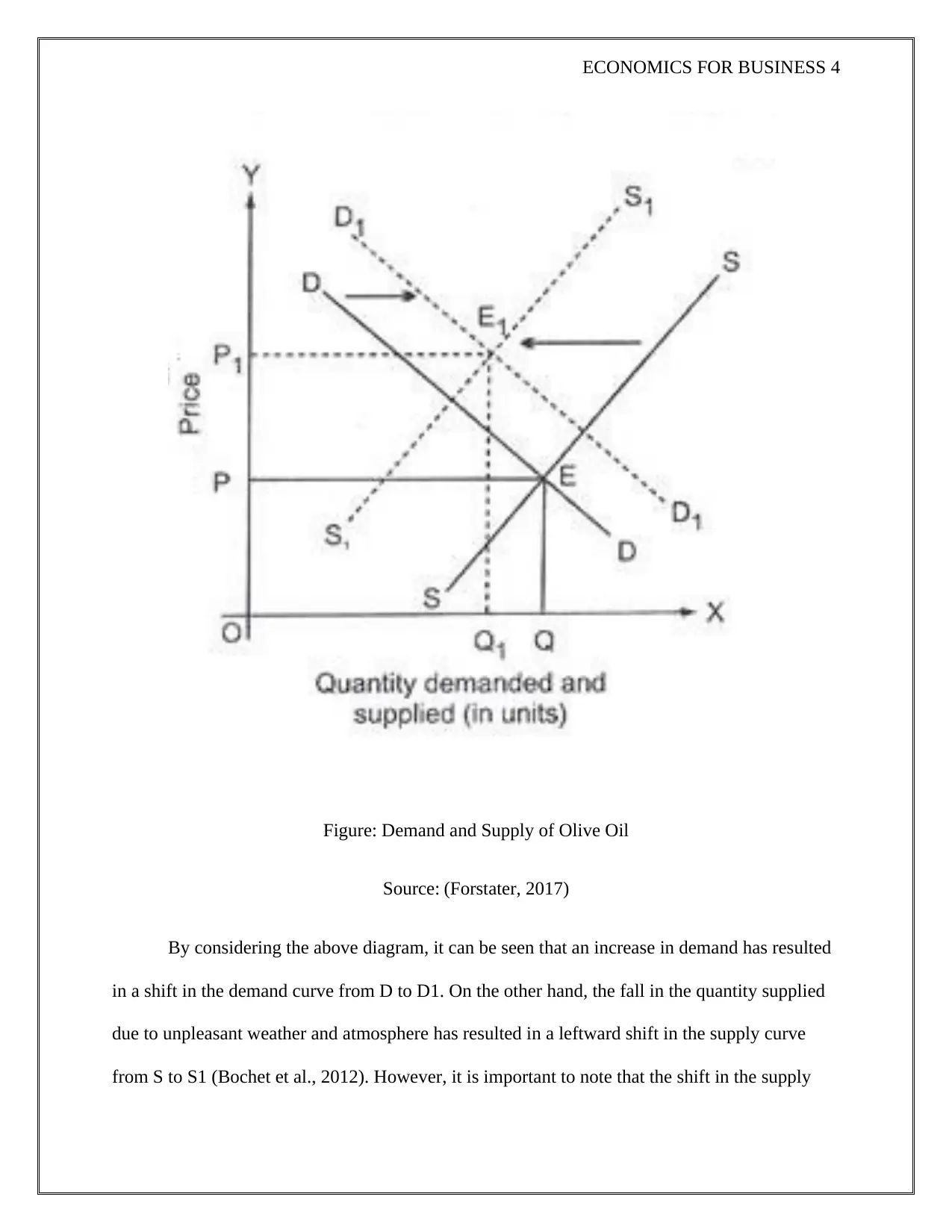
ECONOMICS FOR BUSINESS 4
Figure: Demand and Supply of Olive Oil
Source: (Forstater, 2017)
By considering the above diagram, it can be seen that an increase in demand has resulted
in a shift in the demand curve from D to D1. On the other hand, the fall in the quantity supplied
due to unpleasant weather and atmosphere has resulted in a leftward shift in the supply curve
from S to S1 (Bochet et al., 2012). However, it is important to note that the shift in the supply
Figure: Demand and Supply of Olive Oil
Source: (Forstater, 2017)
By considering the above diagram, it can be seen that an increase in demand has resulted
in a shift in the demand curve from D to D1. On the other hand, the fall in the quantity supplied
due to unpleasant weather and atmosphere has resulted in a leftward shift in the supply curve
from S to S1 (Bochet et al., 2012). However, it is important to note that the shift in the supply
Paraphrase This Document
Need a fresh take? Get an instant paraphrase of this document with our AI Paraphraser
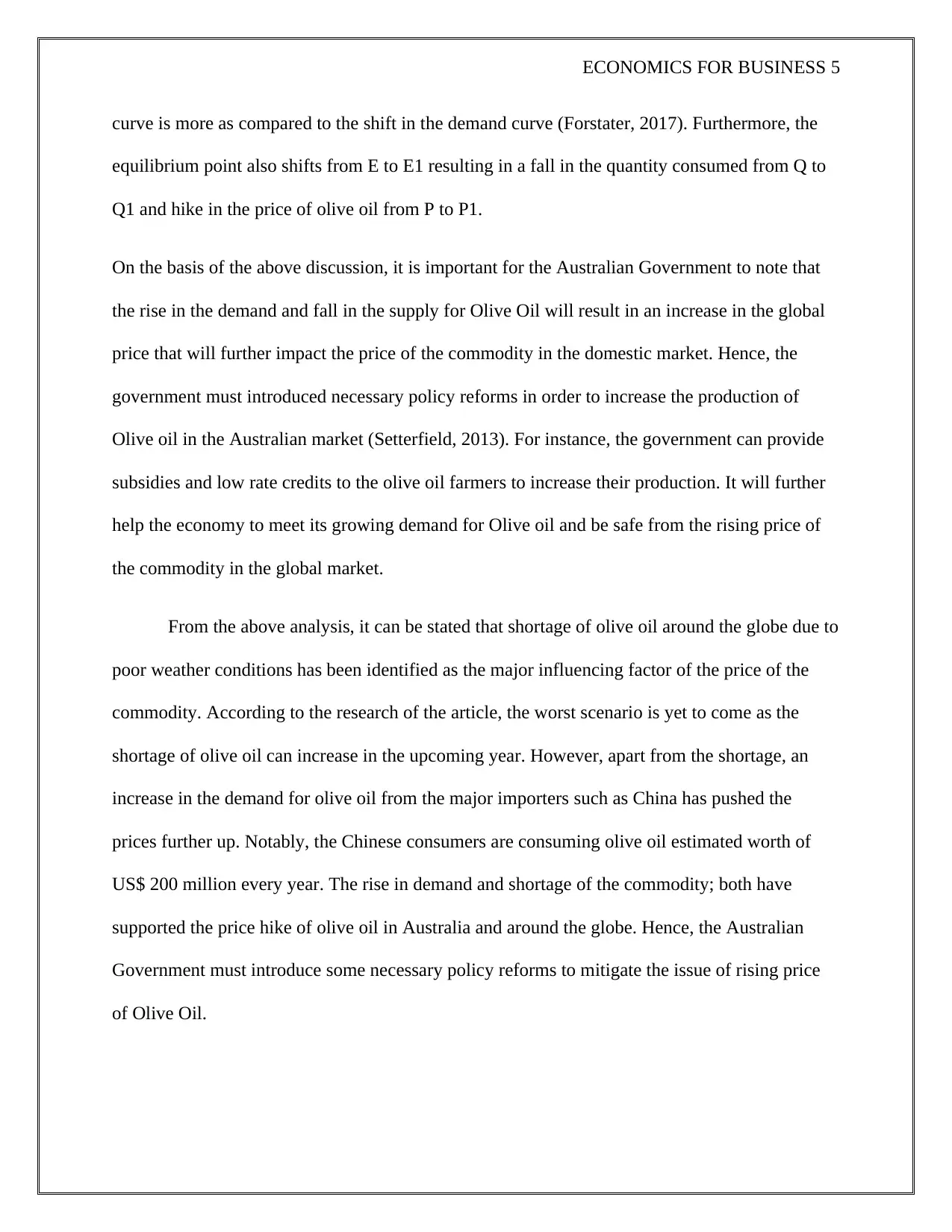
ECONOMICS FOR BUSINESS 5
curve is more as compared to the shift in the demand curve (Forstater, 2017). Furthermore, the
equilibrium point also shifts from E to E1 resulting in a fall in the quantity consumed from Q to
Q1 and hike in the price of olive oil from P to P1.
On the basis of the above discussion, it is important for the Australian Government to note that
the rise in the demand and fall in the supply for Olive Oil will result in an increase in the global
price that will further impact the price of the commodity in the domestic market. Hence, the
government must introduced necessary policy reforms in order to increase the production of
Olive oil in the Australian market (Setterfield, 2013). For instance, the government can provide
subsidies and low rate credits to the olive oil farmers to increase their production. It will further
help the economy to meet its growing demand for Olive oil and be safe from the rising price of
the commodity in the global market.
From the above analysis, it can be stated that shortage of olive oil around the globe due to
poor weather conditions has been identified as the major influencing factor of the price of the
commodity. According to the research of the article, the worst scenario is yet to come as the
shortage of olive oil can increase in the upcoming year. However, apart from the shortage, an
increase in the demand for olive oil from the major importers such as China has pushed the
prices further up. Notably, the Chinese consumers are consuming olive oil estimated worth of
US$ 200 million every year. The rise in demand and shortage of the commodity; both have
supported the price hike of olive oil in Australia and around the globe. Hence, the Australian
Government must introduce some necessary policy reforms to mitigate the issue of rising price
of Olive Oil.
curve is more as compared to the shift in the demand curve (Forstater, 2017). Furthermore, the
equilibrium point also shifts from E to E1 resulting in a fall in the quantity consumed from Q to
Q1 and hike in the price of olive oil from P to P1.
On the basis of the above discussion, it is important for the Australian Government to note that
the rise in the demand and fall in the supply for Olive Oil will result in an increase in the global
price that will further impact the price of the commodity in the domestic market. Hence, the
government must introduced necessary policy reforms in order to increase the production of
Olive oil in the Australian market (Setterfield, 2013). For instance, the government can provide
subsidies and low rate credits to the olive oil farmers to increase their production. It will further
help the economy to meet its growing demand for Olive oil and be safe from the rising price of
the commodity in the global market.
From the above analysis, it can be stated that shortage of olive oil around the globe due to
poor weather conditions has been identified as the major influencing factor of the price of the
commodity. According to the research of the article, the worst scenario is yet to come as the
shortage of olive oil can increase in the upcoming year. However, apart from the shortage, an
increase in the demand for olive oil from the major importers such as China has pushed the
prices further up. Notably, the Chinese consumers are consuming olive oil estimated worth of
US$ 200 million every year. The rise in demand and shortage of the commodity; both have
supported the price hike of olive oil in Australia and around the globe. Hence, the Australian
Government must introduce some necessary policy reforms to mitigate the issue of rising price
of Olive Oil.
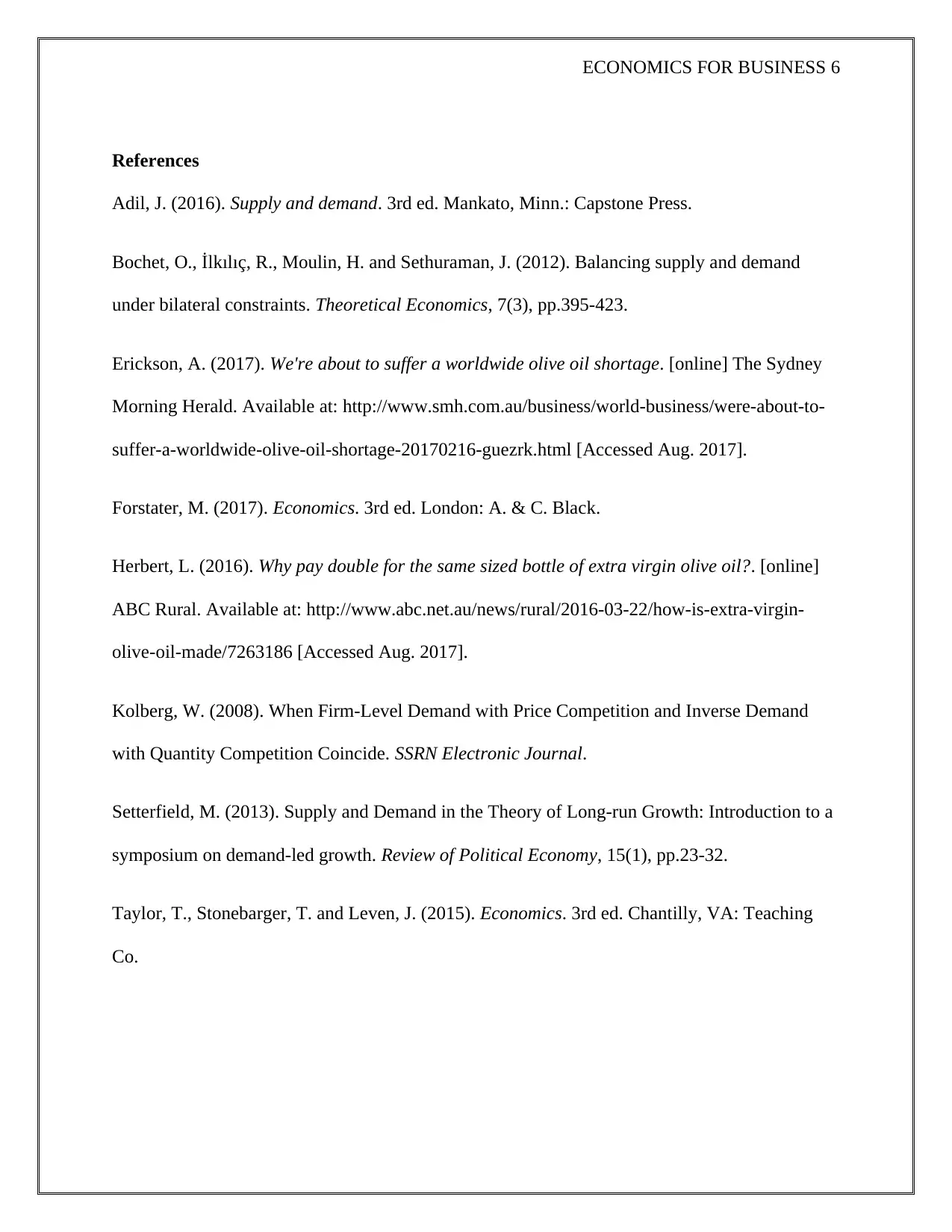
ECONOMICS FOR BUSINESS 6
References
Adil, J. (2016). Supply and demand. 3rd ed. Mankato, Minn.: Capstone Press.
Bochet, O., İlkılıç, R., Moulin, H. and Sethuraman, J. (2012). Balancing supply and demand
under bilateral constraints. Theoretical Economics, 7(3), pp.395-423.
Erickson, A. (2017). We're about to suffer a worldwide olive oil shortage. [online] The Sydney
Morning Herald. Available at: http://www.smh.com.au/business/world-business/were-about-to-
suffer-a-worldwide-olive-oil-shortage-20170216-guezrk.html [Accessed Aug. 2017].
Forstater, M. (2017). Economics. 3rd ed. London: A. & C. Black.
Herbert, L. (2016). Why pay double for the same sized bottle of extra virgin olive oil?. [online]
ABC Rural. Available at: http://www.abc.net.au/news/rural/2016-03-22/how-is-extra-virgin-
olive-oil-made/7263186 [Accessed Aug. 2017].
Kolberg, W. (2008). When Firm-Level Demand with Price Competition and Inverse Demand
with Quantity Competition Coincide. SSRN Electronic Journal.
Setterfield, M. (2013). Supply and Demand in the Theory of Long-run Growth: Introduction to a
symposium on demand-led growth. Review of Political Economy, 15(1), pp.23-32.
Taylor, T., Stonebarger, T. and Leven, J. (2015). Economics. 3rd ed. Chantilly, VA: Teaching
Co.
References
Adil, J. (2016). Supply and demand. 3rd ed. Mankato, Minn.: Capstone Press.
Bochet, O., İlkılıç, R., Moulin, H. and Sethuraman, J. (2012). Balancing supply and demand
under bilateral constraints. Theoretical Economics, 7(3), pp.395-423.
Erickson, A. (2017). We're about to suffer a worldwide olive oil shortage. [online] The Sydney
Morning Herald. Available at: http://www.smh.com.au/business/world-business/were-about-to-
suffer-a-worldwide-olive-oil-shortage-20170216-guezrk.html [Accessed Aug. 2017].
Forstater, M. (2017). Economics. 3rd ed. London: A. & C. Black.
Herbert, L. (2016). Why pay double for the same sized bottle of extra virgin olive oil?. [online]
ABC Rural. Available at: http://www.abc.net.au/news/rural/2016-03-22/how-is-extra-virgin-
olive-oil-made/7263186 [Accessed Aug. 2017].
Kolberg, W. (2008). When Firm-Level Demand with Price Competition and Inverse Demand
with Quantity Competition Coincide. SSRN Electronic Journal.
Setterfield, M. (2013). Supply and Demand in the Theory of Long-run Growth: Introduction to a
symposium on demand-led growth. Review of Political Economy, 15(1), pp.23-32.
Taylor, T., Stonebarger, T. and Leven, J. (2015). Economics. 3rd ed. Chantilly, VA: Teaching
Co.
⊘ This is a preview!⊘
Do you want full access?
Subscribe today to unlock all pages.

Trusted by 1+ million students worldwide
1 out of 6
Related Documents
Your All-in-One AI-Powered Toolkit for Academic Success.
+13062052269
info@desklib.com
Available 24*7 on WhatsApp / Email
![[object Object]](/_next/static/media/star-bottom.7253800d.svg)
Unlock your academic potential
Copyright © 2020–2025 A2Z Services. All Rights Reserved. Developed and managed by ZUCOL.





